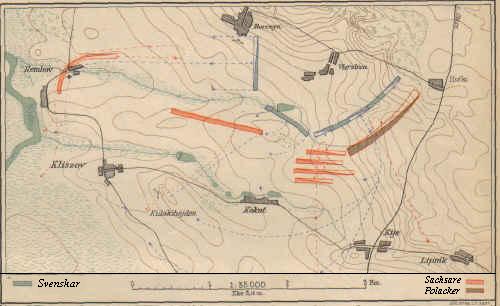|


The battle of Kliszow, which
was fought 9 July (Swedish calendar) or 19 July 1702 (Gregorian calendar) in
southern Poland, was one of the greatest Swedish victories in the Great
Northern War. It was also the first battle the Swedish king Charles XII led
by himself without the help of battle plans devised by other generals. The
Swedish army had also defeated the Saxon army the year before when the
Swedes successfully crossed the river
Düna. But the Saxons managed to leave that battle field without serious
casualties. In an attempt to eliminate the Saxons as a military threat the
Swedish army marched to southern Poland in 1702 where the Saxon army was
located. The Swedes had however only 12 000 men against at least 16 000
Saxons, and when the battle had begun the Saxons were reinforced with a
Polish cavalry force of 8 000 men. But despite the numerical inferiority and
facing attacks on both flanks the Swedes managed to defeat their opponents
and win a decisive victory.
The Saxons lost 2 000 men in
killed and injured and an additional 2 000 men were captured. On the Swedish side 300 men
were killed and 500-800 were injured. The casualties were however not evenly
distributed. In the Guard (Livgardet) had 250 men died and 200 had been
injured while
Närke-Värmland only reported one dead and the Dal-regiment and Västmanland
had neither any dead or injured.
Nevertheless, the campaign in
Poland was not over with this battle. It would continue for an additional
four years until it was finally decided by the
battle of Fraustadt.
The map above
comes from the work by the Swedish General Staff "Karl XII på slagfältet" and
shows the Swedish army's difficult position just after the arrival of the
Poles.
The map has been slightly modified by me to reduce its size and increase
readability. |

